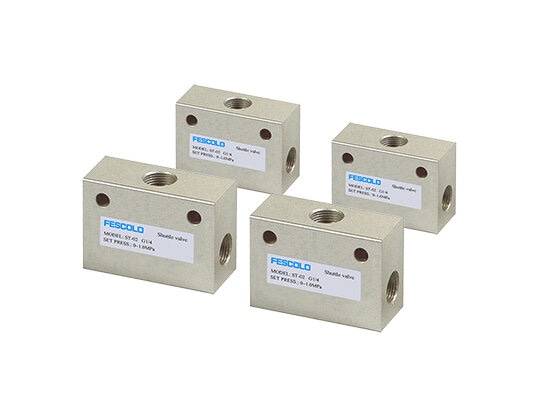
Shuttle valves are essential components in fluid control systems, designed to manage and direct the flow of fluids between two different paths based on certain operational conditions. These valves play a crucial role in various industries, offering a reliable solution for systems that require the switching of flow from one input to another.
Shuttle valves are widely used in both hydraulic and pneumatic systems and can also be referred to as "pneumatic shuttle valve" and "hydraulic shuttle valve."
They are designed to control the direction of fluid flow, typically selecting one of two input sources and directing the fluid to a single output port.
The valve ensures that if one input source fails, the system automatically switches to the other source, ensuring continuous operation of the system.
The function of a shuttle valve is to control the flow of fluid or gas by selecting one of two input sources and directing the flow to a single output. When one input source fails, it automatically switches to the backup source, providing redundancy to ensure the continuous operation of the system. Shuttle valves are commonly used in systems that require direction control, pressure switching, and continuous operation during power failure. They help enhance the reliability and stability of pneumatic and hydraulic systems.
Redundancy Function: In hydraulic systems, shuttle valves automatically switch to a backup hydraulic source. For example, when the primary hydraulic source fails, the shuttle valve directs fluid from the backup source to the system, ensuring continuous operation of hydraulic equipment.
Bidirectional Control: Shuttle valves can control the direction of fluid flow. For instance, in a hydraulic control system, shuttle valves can direct hydraulic oil to different actuators, ensuring smooth hydraulic operation.
Pressure Switching: In some hydraulic systems, shuttle valves can select the appropriate hydraulic source based on different pressure levels, helping to regulate the working pressure within the system.
Efficient Switching: Shuttle valves can quickly and seamlessly switch the direction of fluid flow, improving system efficiency and reducing pressure fluctuations caused by changes in hydraulic sources.
Pneumatic Systems: Shuttle valves are used in pneumatic systems to switch the direction of airflow to different actuators or devices, ensuring smooth operation of automated systems.
Redundancy and Backup: In systems with two air sources, if the primary air source fails, the shuttle valve automatically switches to the backup air source, ensuring continuous operation.
Hydraulic Systems: In hydraulic systems, shuttle valves are used to switch between two pressure sources, helping to control fluid flow and maintain stable operation under varying pressure conditions.
Shuttle valve, also known as bidirectional control valve, is a valve that functions similarly to an OR logic gate. It has two entrances (P1 and P2) and one exit (A)
Shuttle valves are widely used in pneumatic systems. They are commonly used in parallel circuits for manual and automatic control, for example, using two manual buttons to control the forward and backward movement of a double acting cylinder. When either of the two button valves is operated, the piston rod of the cylinder extends, and only when both button valves are released, the piston rod retracts.In addition, shuttle valves are also used in logic circuits and pneumatic program control circuits for signal processing and distribution
In hydraulic systems, the shuttle valve block represents a hydraulic shuttle valve model based on a data table
Any signal input from port P1 or P2 will result in an output from port A. If both ports P1 and P2 have signal inputs, the signal from the port with higher pressure will be output through port A, while the other port will be blocked. Only when there is no signal input from ports P1 and P2, port A will not output.
FOKCA ©1998-2025 Fescolo Pneumatic All Rights Reserved Sitemap